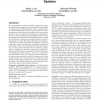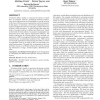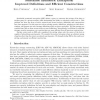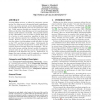CCS
2006
ACM
14 years 4 months ago
2006
ACM
Traditional security policies largely focus on access control requirements, which specify who can access what under what circumstances. Besides access control requirements, the av...
CCS
2006
ACM
14 years 4 months ago
2006
ACM
In trust negotiation and other distributed proving systems, networked entities cooperate to form proofs that are justified by collections of certified attributes. These attributes...
CCS
2006
ACM
14 years 4 months ago
2006
ACM
We introduce the notion of resiliency policies in the context of access control systems. Such policies require an access control system to be resilient to the absence of users. An...
CCS
2006
ACM
14 years 4 months ago
2006
ACM
Attributes define, classify, or annotate the datum to which they are assigned. However, traditional attribute architectures and cryptosystems are ill-equipped to provide security ...
CCS
2006
ACM
14 years 4 months ago
2006
ACM
As more sensitive data is shared and stored by third-party sites on the Internet, there will be a need to encrypt data stored at these sites. One drawback of encrypting data, is t...
CCS
2006
ACM
14 years 4 months ago
2006
ACM
Searchable symmetric encryption (SSE) allows a party to outsource the storage of his data to another party in a private manner, while maintaining the ability to selectively search...
CCS
2006
ACM
14 years 4 months ago
2006
ACM
Consider a pollster who wishes to collect private, sensitive data from a number of distrustful individuals. How might the pollster convince the respondents that it is trustworthy?...
CCS
2006
ACM
14 years 4 months ago
2006
ACM
Attackers often try to evade an intrusion detection system (IDS) when launching their attacks. There have been several published studies in evasion attacks, some with available to...
CCS
2006
ACM
14 years 4 months ago
2006
ACM
In biology, a vaccine is a weakened strain of a virus or bacterium that is intentionally injected into the body for the purpose of stimulating antibody production. Inspired by thi...
CCS
2006
ACM
14 years 4 months ago
2006
ACM
Location-hidden services, as offered by anonymity systems such as Tor, allow servers to be operated under a pseudonym. As Tor is an overlay network, servers hosting hidden service...





